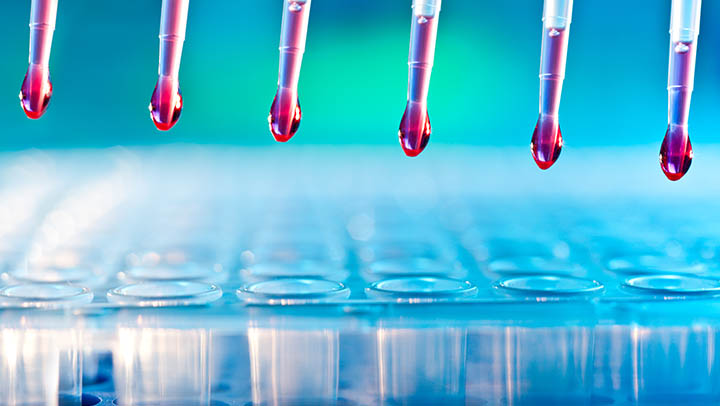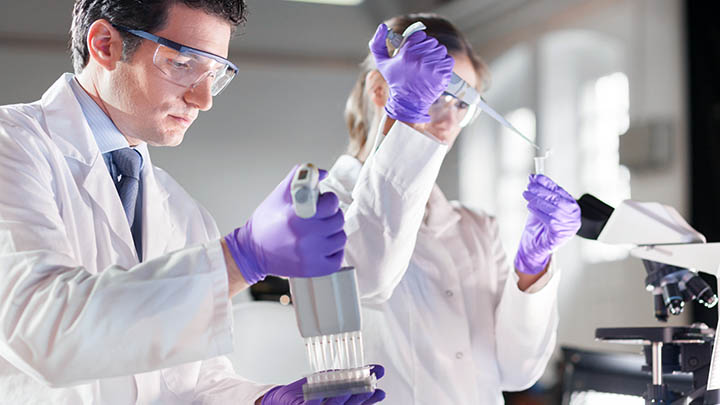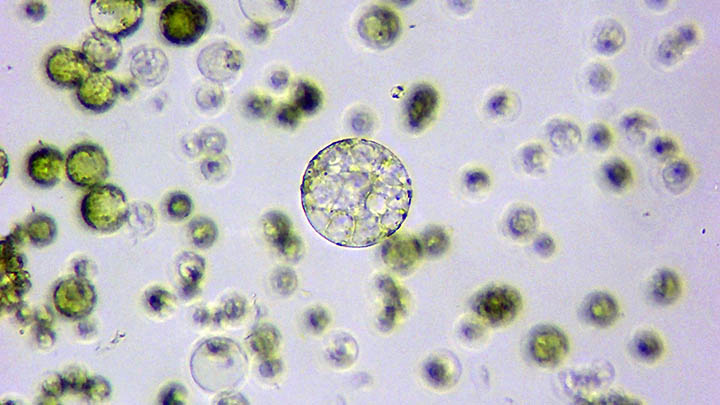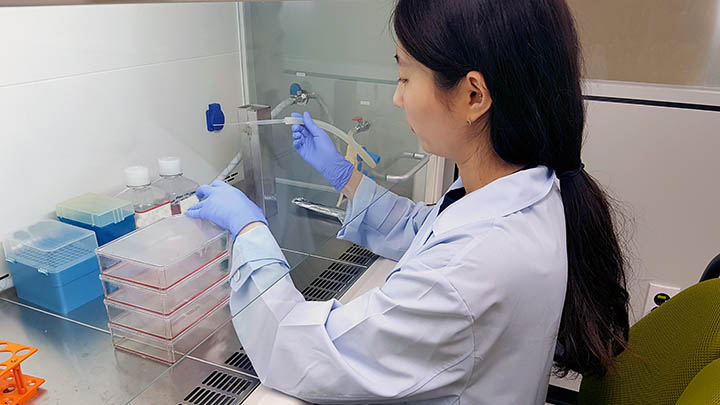Building experimental models using cutting-edge genetic manipulation
The Genome Editing Unit (GEU) applies the latest molecular technologies to help generate your research models, from plasmid vectors and cultured cells to whole organisms.
With years of experience applying CRISPR-Cas9, and access to the ever growing molecular toolbox, we work with you to build better, bespoke research models to truly reflect your biological system of interest.
Every project we undertake is different. We provide guidance, and tailor our expertise to develop tools according to your needs.
How we work
Training, services and support
We produce bespoke experimental models, working in collaboration with our research colleagues. We provide training and support to our users.
Contact us for more information.
Services
Our staff are experts in the application of genetic manipulation techniques in a variety of model systems. We advise you on the best way to make your models, and then put it into practice.
The facility is managed full time by an experienced Senior Experimental Officer, and service arms are led by Experimental Officers and Technicians.

Training
We want to ensure user groups take a genetically modified model product from us, and understand how it was made. We offer support and training to our user groups on all aspects of the process, from in silico design through to detecting the desired genetic manipulation
Training is provided in multiple formats, including workshops, seminars, and one-to-one sessions.

Applications
Our activities
The facility has four arms of activity, covering a range of services and support.
We offer a complete service from concept to germline confirmed transgenic mouse line.
This includes project design, preparation and purification of reagents, the generation of the transgenic mouse through embryo microinjection, and confirmation of germline transmission.
Typical CRISPR gene edited mouse models include:
- gene knockouts;
- genomic deletions;
- point mutations;
- conditional alleles;
- reporter tagged genes;
- Cre drivers.
We also have experience with a range of alternative transgenesis techniques, including integration of recombinant plasmids and/or bacterial artificial chromosomes (BACs).
We have built viral vectors for use in in vivo, including AAV-Cre and AAV-CRISPR, allowing you to perform genetic manipulations without the need to create a new transgenic line.
We also offer services to cryopreserve transgenic strains and revive cryopreserved colonies. We help to arrange importing strains from collaborators or external laboratories.
Exploiting our expertise with CRISPR-Cas9, we have recently added cell line engineering to our service portfolio.
We offer a modular service, where the research group can pay for different aspects of the sequential process according to their budget.
We offer a range of services, including:
- optimising CRISPR knockout for your cell line of choice;
- designing and screening gRNA for your target gene knockout;
- designing CRISPR to create single nucleotide changes;
- targeted knock-in of larger sequences such as transcriptional reporters, fluorescent fusion genes, or whole transgenes;
- generating modified cells as either a pooled or clonal population.
We also have expertise in the construction and application of classic overexpression systems, such as plasmid or lentivirus.
We want to ensure the next generation of scientists gain working knowledge of the cutting-edge techniques we apply. We are keen to train staff and students as part of this service.
Our team has years of experience building custom plasmids according to researcher needs, using a variety of molecular biology techniques.
With a library of plasmids and gene tags to choose from, we can build custom genetically encoded constructs for a range of downstream applications, including CRISPR donors and gene expression plasmids, and lentiviral vectors.
We can add functional tags to your genes, including:
- fluorescent proteins;
- luminescent reporters;
- proximity labelling enzymes;
- pull down epitopes;
- multifunctional tags (such as HaloTag);
- inducible protein depletion degron tags.
We also design and clone CRISPR vectors to create genetically modified Drosophila, in collaboration with our colleagues in the Fly Facility.
The GEU works closely with the Manchester Fly Facility to offer a range of services.
The fruit fly Drosophila melanogaster has been a popular research model for over 100 years. It’s highly genetically tractable, and commonly used to investigate fundamental principles of genetics, development and neuroscience.
Working with the Facility we have established services and workflows to create gene knockout and gene knock in fly models.
Stem cells have emerged as a key research tool over the last decade, especially in fields of rare disease modelling and therapeutic screening.
We have established new stem cell capabilities and are able to generate and genetically manipulate stem cells to order.
Our services include:
- generation of induced pluripotent stem cells from primary tissue or blood;
- gene editing, including gene knockout, mutation correction/creation and reporter gene integration of iPSC and ESC lines;
- iPSC/ESC QC services;
- bookable facilities for iPSC/ESC culture and differentiation.
Building on the revolution in molecular technologies, and as the expert hub of gene editing and molecular biology, we have collaborated with local research groups to apply the latest molecular technologies in novel contexts.
We have integrated research and development capacity, and can discuss your project requirements to see if we can assist by building bespoke technologies for specific research goals. Where appropriate, we can collaborate on grant applications.
We have supported a diverse range of technology application and development, including:
- adapting CRISPR for other model organisms and systems (zebrafish, Drosophila, stem cells);
- applying gene perturbation technologies such as CRISPRinteference, CRISPRactivation and CRISPR-Cas13;
- building expression systems with temporal control, such as doxycycline inducible promoters, and controlled protein depletion using Degrons;
- integrated CRISPR diagnostics for programmable sequence detection.
We have also assisted local groups with the design and development of putative gene and cell therapy approaches for genetic disease.
Publications and outputs
Contributing to high impact outputs
The Genome Editing Unit has been instrumental in research leading to several high impact publications.
Stem Cell Research, 2024.
We have recently added Stem cell services, and in this study we assisted in the creation of novel human embryonic stem cell lines with integrated fluorescent reporters that can be used to track cardiac differentiation.
Nature Communications, 2023.
In this study our team used CRISPR-Cas9 to precisely create a novel mouse model replicating a human genetic variant associated with obesity.
Proceedings of the National Academy of Sciences (PNAS), 2020.
To our knowledge this is the first example of a CRISPR knock-in mouse expressing a HaloTag-gene fusion (Halotag-Reverbα).
This transforms the capacity to perform live single cell imaging combined with dynamic Chip-seq analysis of rhythmically expressed proteins, and allowed us to build an accurate map of the Reverbα cistrome revealing a new role for hepatic Reverbα.
Nature Communication, 2020.
Genome-wide association studies (GWAS) has identified large numbers of credible disease (psoriasis and arthritis) associated SNPs that reside in non-coding genomic regions.
We assisted with a strategy to functionally probe these sequences, predicted to be enhancers and regulatory regions, using the derivative CRISPRactivation technology.
With this approach, the group has been able to identify genes that are under the transcriptional regulatory control of these putative enhancers.
Methods, 2021.
This is a core facility led paper.
There is a pressing need to improve the DNA donors used in CRISPR knock-in in mouse embryo. Increasing the efficiency of gene knock-in would have significant 3Rs impact.
Long ssDNA donors have emerged as optimal donors with increased rates of knock-in via homology directed repair (HDR).
However, present synthesis methods do not produce adequate yields and often contain sequence errors. The method we developed in-house resolves these issues, generating high yield, sequence perfect lssDNA.
As a core facility, we have shared this technique with several local research groups to use in difficult-to-transfect cultured cells and zebrafish embryos.
Genome Biology, 2019.
Conditional alleles are a popular transgenic mouse model. However, published methods to generate such transgenic mice were shown to be low efficiency when applied at scale.
As a lead centre within this consortium of transgenic core facilities worldwide we contributed CRISPR data from several projects, helping highlight flaws with the current methods for generating conditional alleles in mice, as well as provide data for alternative, more efficient strategies.
External access
Working with industry and other academic institutions
Although primarily focused on supporting research at The University of Manchester, we are also able to support work from other academic institutions and industry.
Please contact our Business Development Manager for further details if you are interested in accessing the facility
Dr Joanne Flannelly
Email: joanne.flannelly@manchester.ac.uk
Academic institutions
We have generated transgenic mouse models, cell lines and custom vectors for collaborators in academia.
Our capacity for performing external work is dependent on our internal workload and on the complexity of the work to be performed.

Industry
We have worked with a number of companies in a variety of capacities.
All work is fully documented and contractual and non-disclosure compliance is assured.
Please note that due to patents and licensing, we do not have the freedom to operate with some technologies for industry clients.

Contact us
Find out more
Get in touch for further information or to inquire about using our facility.
Antony Adamson, Senior Experimental Officer
Email: genome.editing@manchester.ac.uk
Genome Editing Unit
Michael Smith Building
The University of Manchester
Oxford Road
Manchester
M13 9PT
Maps and travel
We are based in the Michael Smith Building (Building 71 on the University campus map).
Technology platforms
Technology platforms
We have a pioneering environment and facilities for research, innovation and technology development.
Technology platforms main page
